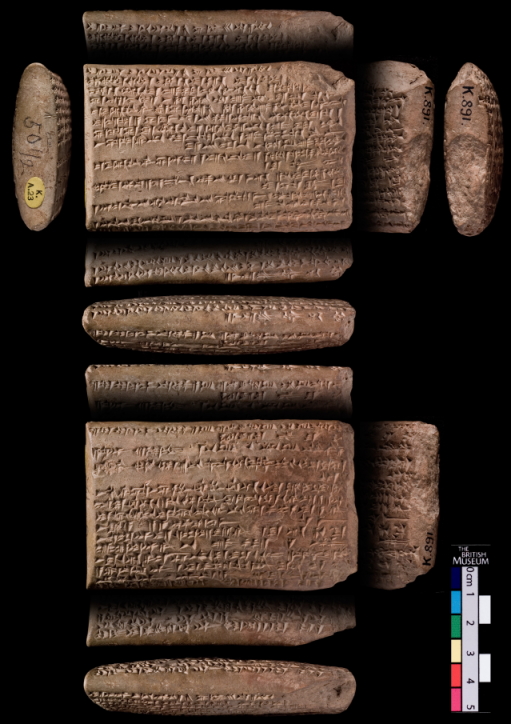The Lament of Ashurbanipal

This royal inscription / lament is found on one tablet, K. 891, housed in the British Museum. Judging from the bibliographical references in the British Museum's object record (see →here), the text enjoyed considerable attention in the late nineteenth century. Streck's German edition, published in 1916 (2.248-253; →bibliography; →library), served as the only available edition of the text for almost one hundred years. Novotny (2014: 45, 80–81, 99; →bibliography) offers a handbook edition of the text and a translation. And, Novotny and Jeffers, working on the royal inscriptions of the Neo-Assyrian period, have offered a new, critical edition of the text in RINAP 5/2, no. 185 (2022; →bibliography; →open-access), freely available on ORACC (→see here). Their transliteration forms the basis of the text below, though I have collated the tablet myself and, building on an idea from Streck's old edition (1916), restored obv. 10. Another difference here that harks back to Streck: I believe prose gives way to verse in the lament section of the text, that is, in rev. 3-13.
The lament has not received the attention that it deserves. Luckenbill offered an English translation in 1927 (2.377-378→bibliography; →library), and a few scholars have made passing observations about the text (e.g., Foster 2007: 43; Sanders 2009: 165,n.37; and Finn 2017: 83; further bibliography is available in RINAP 5/2, p. 223). But, there are no studies as far as I can determine focused on the exposition of this very interesting text aside from my own recent work on the text in the context of my monograph on Ludlul bēl nēmeqi (Lenzi 2023; →open-access).
The text is easily divided into two main sections, the prose enumeration of the king's pious acts in obv. 1 to rev. 2 and the king's lament in verse in rev. 3 to rev. 13. The prose section itself is highly structured in that obv. 1-9 lists the king's acts that directly benefit the gods, obv. 10-13 recounts his acts that benefit living human beings (and indirectly the gods as well), and rev. 1 mentions the king's acts that benefit deceased human beings. Rev. 2 summarizes the various acts toward each group and forms a transition to the lament (rev. 3-13). In my scanning of the verses, I see two quatrains in rev. 3-6 and rev. 7-10: the first one recounts the bad things that have happened to Ashurbanipal, and the second describes his personal reaction to the unfavorable events. The long line in rev. 11 stands alone. The text then ends with a final couplet in rev. 12-13.
The lament has not received the attention that it deserves. Luckenbill offered an English translation in 1927 (2.377-378→bibliography; →library), and a few scholars have made passing observations about the text (e.g., Foster 2007: 43; Sanders 2009: 165,n.37; and Finn 2017: 83; further bibliography is available in RINAP 5/2, p. 223). But, there are no studies as far as I can determine focused on the exposition of this very interesting text aside from my own recent work on the text in the context of my monograph on Ludlul bēl nēmeqi (Lenzi 2023; →open-access).
The text is easily divided into two main sections, the prose enumeration of the king's pious acts in obv. 1 to rev. 2 and the king's lament in verse in rev. 3 to rev. 13. The prose section itself is highly structured in that obv. 1-9 lists the king's acts that directly benefit the gods, obv. 10-13 recounts his acts that benefit living human beings (and indirectly the gods as well), and rev. 1 mentions the king's acts that benefit deceased human beings. Rev. 2 summarizes the various acts toward each group and forms a transition to the lament (rev. 3-13). In my scanning of the verses, I see two quatrains in rev. 3-6 and rev. 7-10: the first one recounts the bad things that have happened to Ashurbanipal, and the second describes his personal reaction to the unfavorable events. The long line in rev. 11 stands alone. The text then ends with a final couplet in rev. 12-13.

